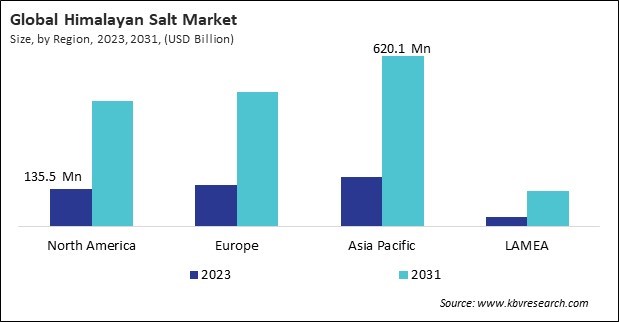Int'l : +1(646) 832-2886 | query@kbvresearch.com
Int'l : +1(646) 832-2886 | query@kbvresearch.com
Industry Insights | Market Trends | Highest number of Tables | 24/7 Analyst Support
According to a new report, published by KBV research, The Global Himalayan Salt Market size is expected to reach $1.7 billion by 2031, rising at a market growth of 17.8% CAGR during the forecast period. In the year 2023, the market attained a volume of 59,482.0 tonnes, experiencing a growth of 6.4% (2020-2023).
The White Salt segment is anticipating a CAGR of 18.6% during (2024 - 2031). White Himalayan salt lacks the distinctive color imparted by trace minerals, which some consumers prefer for a more neutral appearance in their dishes. This type of salt is particularly favored by those who prioritize purity and a clean, mild taste in their cooking. Additionally, white Himalayan salt is often used in food processing and preservation, maintaining its demand in household and industrial applications. The versatility of white salt, combined with its availability and the perception of it being a less processed and purer form of salt, continues to drive its steady presence in the market.

The Granular segment is leading the Global Himalayan Salt Market by Form in 2023; thereby, achieving a market value of $653.6 million by 2031. This Himalayan salt is particularly popular due to its versatility and ease of use in various culinary applications. Granular Himalayan salt is often used as a finishing salt, providing a pleasing texture and a burst of flavor when sprinkled over dishes. Its coarse, crystalline structure also makes it ideal for use in salt grinders, allowing consumers to freshly grind salt for optimal flavor.
The Foodservice segment is registering a CAGR of 18% during (2024 - 2031). This segment includes restaurants, hotels, and catering services, where Himalayan salt is used for its flavor and aesthetic appeal in gourmet cooking and presentation. Chefs and foodservice providers favor Himalayan salt for its ability to enhance the taste and the visual presentation of dishes, making it a popular choice in fine dining and upscale eateries. The rise of global cuisines and the increasing trend of using specialty salts in culinary arts have further boosted the demand for Himalayan salt in the foodservice industry.
Full Report: https://www.kbvresearch.com/himalayan-salt-market/
The Asia Pacific region dominated the Global Himalayan Salt Market by Region in 2023, and would continue to be a dominant market till 2031; thereby, achieving a market value of $620.2 million by 2031. The Europe region is experiencing a CAGR of 17.1% during (2024 - 2031). Additionally, The North America region would exhibit a CAGR of 17.6% during (2024 - 2031).
By Type (Volume, Tonnes, USD Billion, 2020-2031)
By Form (Volume, Tonnes, USD Billion, 2020-2031)
By End Use (Volume, Tonnes, USD Billion, 2020-2031)
By Geography (Volume, Tonnes, USD Billion, 2020-2031)
Related Reports: